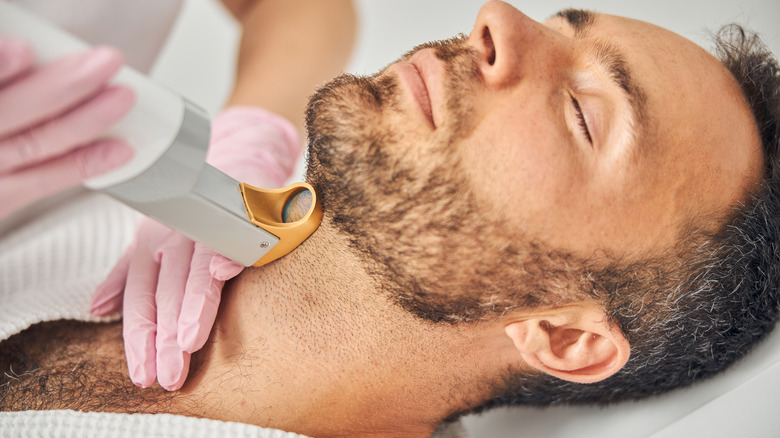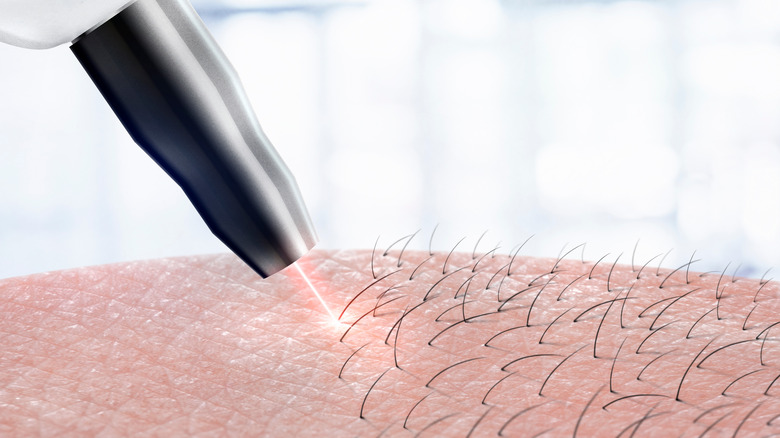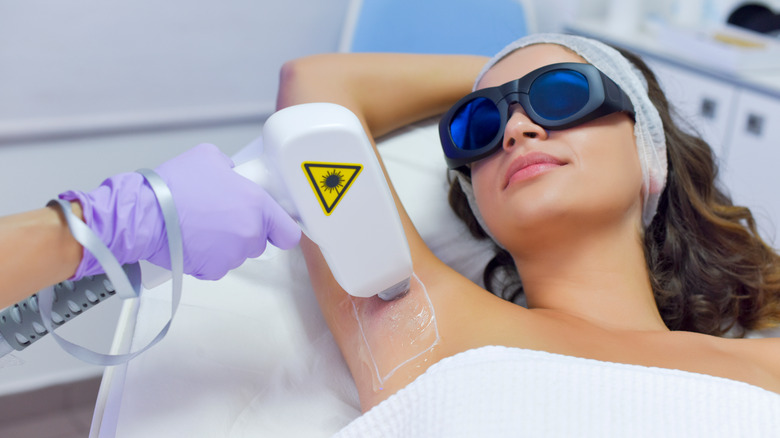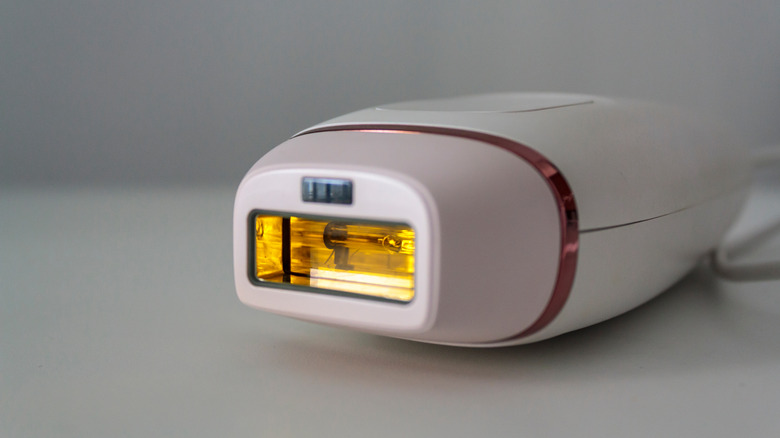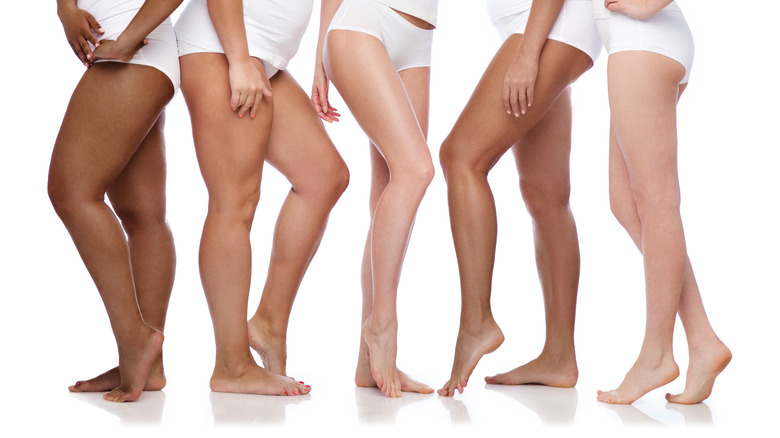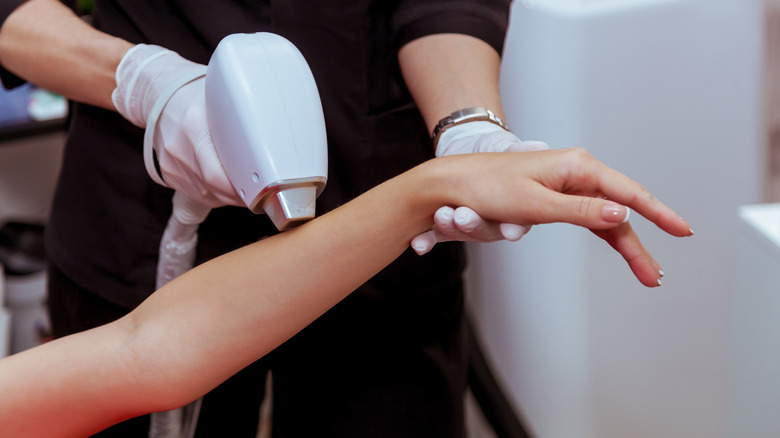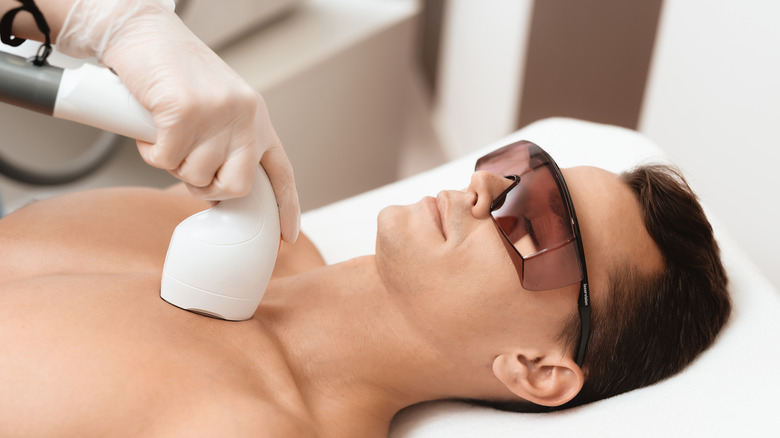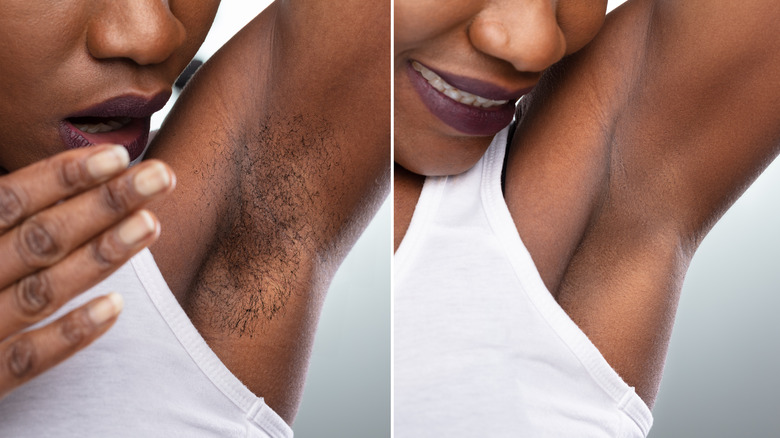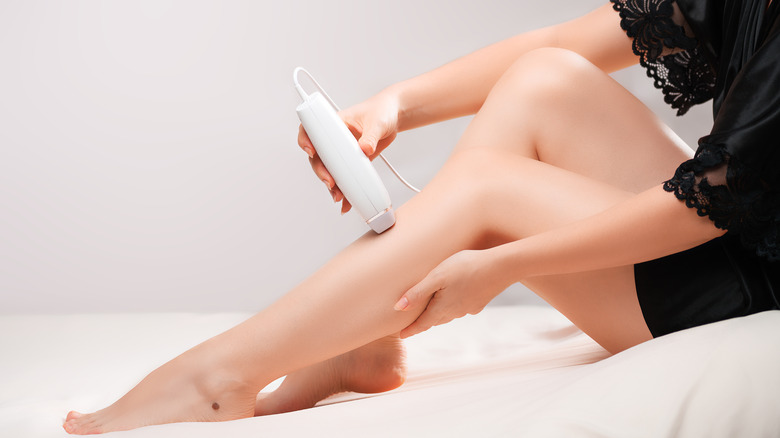Everything You Should Know Before Getting Laser Hair Removal
There's nothing more natural than body hair, but we live in a culture that glorifies silky smooth skin for women and tasteful manscaping for men (via Time). But constantly shaving, plucking, waxing, and epilating in an attempt to live up to these ideals can be time-consuming, lead to skin irritation and painful ingrown hairs, and cost a pretty penny over the years. It's no surprise, then, that many people want a permanent way to get rid of their unwanted body hair.
For years, that's exactly what laser hair removal (LHR) has promised, and the allure of being able to finally retire your razor or break up with your waxer has led many people to give this cosmetic procedure a try. In 2020, the global LHR market was valued at almost $444 million and is expected to grow by more than 20% in the coming years (via Grand View Research). More than half of LHR sessions are performed in facilities specializing in cosmetic procedures, while about a third are performed in dermatology clinics and a small percentage are done at home. According to Statista, in 2019 more than 450,000 LHR procedures were performed in the United States, making it the fourth-leading cosmetic use for lasers (behind treating sun damage, wrinkles, and facial redness).
But can LHR really deliver permanent results? How do you know which type of laser is right for you? Is the procedure safe and pain-free? How much does it cost, and is a cheaper at-home LHR device a better alternative? Here's everything you need to know.
How laser hair removal works
To understand how laser hair removal (LHR) works, you need to know a little bit about the structure and lifecycle of hair. When we think of body hair, we're thinking of terminal hairs, which are relatively thick and long (via the Anatomy, Hair Follicle). Vellus body hair, on the other hand, is short and very fine (think peach fuzz). Terminal hairs grow from tube-like follicles that extend into the deepest layers of the dermis, the middle layer of the skin. At the bottom of the follicle is the matrix, which is where the cells that make up the growing hair are produced. The hair is composed of three layers: the inner medulla, the surrounding cortex, and the outer cuticle. Like our skin, hair color is dictated by pigment-containing cells called melanocytes. Every hair goes through a three-phase lifecycle. In the anagen phase, the follicle is actively growing a new hair. The catagen phase is a brief period of transition in which the hair stops growing. Hairs are shed during the telogen phase and the cycle begins again.
In LHR, a laser emits energy that is absorbed by the melanin in the hair (via the Mayo Clinic). This energy is converted to heat, and that heat travels down the hair to the follicle matrix, damaging or destroying it. Depending on the degree of damage done to the hair follicle, hair will either take much longer to regrow or will not grow from that follicle ever again.
Who can get laser hair removal (and who should steer clear)
Almost anyone with unwanted body hair can get laser hair removal (LHR). However, LHR is generally not recommended for pregnant women or for individuals who have or have had skin cancer (via the Cleveland Clinic). Certain medications, including prescription-strength retinoids like Accutane used to treat acne, can make people extremely sensitive to light. LHR isn't a good fit for individuals taking those medications. LHR shouldn't be performed in areas with keloid (raised) scars, and individuals with herpes who are prone to cold sores should speak with a healthcare professional before seeking LHR.
In most cases, LHR is considered a cosmetic procedure, and the body hair, while unwanted, isn't considered pathological from a medical perspective. But LHR can also be used to treat a medical condition known as hirsutism. According to the Mayo Clinic, hirsutism is a condition in women that causes excessive growth of thick, dark hair in a male-like pattern. Women with hirsutism have hair in areas such as the face, chest, lower abdomen, inner thigh, and back. Hirsutism is most often caused by high levels of male sex hormones (androgens) and is commonly seen in women with polycystic ovary syndrome (PCOS). Other causes of hirsutism include high levels of cortisol caused by Cushing syndrome and a condition known as congenital adrenal hyperplasia. Some medications, including minoxidil (Rogaine) and certain treatments for endometriosis, can also cause hirsutism.
Laser types
When it comes to laser hair removal (LHR), there are a number of lasers that can get the job done. Each has unique advantages and disadvantages, so it's important to find a clinic that uses the type of laser that's the best fit for you (via LaserAway). Ruby lasers are the OG and have been in use for decades. They're best suited for people with dark hair and light skin, but because they emit a relatively small beam of energy, LHR sessions using Ruby lasers can take a long time. These lasers aren't ideal for larger treatment areas, and many clinics now use other, newer laser types. Alexandrite lasers use a larger beam and are better at covering large areas quickly, plus they can be used on a wider variety of skin and hair color types.
The Nd:YAG laser is newer and preferred by many clinics. Because it can distinguish between subtle differences in pigmentation, it can be used on virtually anyone, regardless of hair color or skin tone. It also emits a large, long beam, meaning fewer LHR sessions are needed and there's less discomfort than with other laser types. Last but certainly not least is the Diode laser. Although this laser is best suited only for people with light-to-medium-toned skin, it's the best at minimizing the risk of skin damage. If you're worried about potential complications (and have a skin/hair combination that's well suited to this laser), the Diode laser is your best bet.
What about IPL?
Another technology you may see advertised as providing permanent hair removal is intense pulsed light (IPL). IPL, however, isn't technically a laser. As Lucy Xu, skin specialist and founder of London Premier Laser and Skin Clinics, explained to Harper's Bazaar: "In contrast to laser hair removal, it uses a broad spectrum of light with multiple wavelengths. This means it has more unfocused energy around the hair and skin area." By contrast, lasers use a single wavelength of light in a very concentrated and defined beam. This makes IPL much weaker than lasers. When used for hair removal, IPL tends to be less effective and necessitate more treatment sessions. It can also cause more discomfort.
But this doesn't mean IPL is totally useless. In fact, the wavelengths of light IPL emits can be particularly helpful for clearing up facial redness caused by broken capillaries or rosacea. IPL is often cheaper than laser treatment, although once you factor in the extra sessions you may need to see decent results, going with IPL may end up being pricier in the long run. Xu and other skincare experts recommend skipping IPL if hair removal is your main goal.
The impact of hair and skin color
Skin color (as well as the color difference between a person's skin and body hair) plays an important role in determining which laser is best for laser hair removal. The most commonly used tool for classifying skin color is the Fitzpatrick Skin Phototype scale (via the Australian Radiation and Nuclear Safety Agency). This scale classifies skin based on its response to UV light, and takes into account genetic factors (physical appearance), sensitivity to sun exposure (burning versus tanning), and intentional exposure (tanning habits). People with Type 1 skin have skin that is pale white and extremely sensitive to the sun. These people always burn and never tan, and tend to have red hair. By contrast, Type IV skin is only mildly sensitive to sun, burns minimally, and always tans to a moderate brown. At the far end of the spectrum is Type VI skin, which is extremely resistant to UV light, never burns, and is very darkly pigmented.
Traditional lasers for LHR work best on people with light skin and dark hair (via Allure). If the pigment difference between skin and hair is too close (either dark skin and dark hair or light skin and light hair), the laser can get "confused" and deliver less-than-stellar results. For those with darker skin tones, the Nd:YAG laser is the best choice, because it can zero in on the pigment in the hair follicle while "ignoring" the pigment in surrounding skin.
You'll need multiple sessions
Unfortunately, laser hair removal (LHR) isn't a "one and done" procedure. As the Cleveland Clinic explains, most people need between six and eight sessions, spaced six to eight weeks apart, to see maximum results.
The reason for this is that LHR only works on hairs that are in the anagen (active growth) phase of their lifecycle (via HairFree). But our hairs aren't synced up; individual hairs right next to each other could be in completely different stages of their lifecycle. How long a hair remains in the anagen phase depends on where it is on the body. Hair on the chin, for instance, grows for about 11–12 months and then enters the catagen (resting) phase for about 2.5 months and the telogen (shedding) phase for about 2–3 weeks. By contrast, armpit hair is in the anagen phase for only about 3.5 months, groin hair grows for approximately 4.5 months, and leg hair is in this phase for about 5.5 months. Another key factor that can influence the number of sessions needed is hair density, as denser body hair requires more treatments. Some hair follicles in the anagen phase will survive the laser, and treatment may actually stimulate dormant hair follicles to "wake up" and start producing hairs, which could also require more sessions.
Cost of laser hair removal
Although laser hair removal (LHR) isn't as pricey as it once was, it still isn't cheap, especially when you consider the fact that you'll need multiple sessions to get the results you're looking for. In a 2021 interview with Forbes, dermatologist Dr. Corey L. Hartman noted that individual treatment sessions usually fall in the $100 to $800 range, but "costs for laser hair removal vary by body area treated, geographical location, the expertise of the person performing the procedure, and time to perform the procedure." In 2020, the average cost of a single LHR session with no other related expenses was $389. Smaller areas, however, can be cheaper. LHR on the face generally averages about $250, while the underarms can range from $175 to $225 per session. The bikini area can range from $250 to $350 per session, depending on whether or not you want a full Brazilian. Large areas like the back and legs will cost more and may be $600 or more per treatment. In the vast majority of cases, health insurance won't cover LHR, unless its performed as part of a treatment plan for a medical condition. But, depending on what form of hair removal you were using before, you might actually be able to save money in the long run with LHR.
That all said, while it may be tempting to try to save some money with a Groupon or other deal, dermatologists don't recommend cutting corners when it comes to LHR (via NewBeauty).
Laser hair removal isn't technically permanent
Although the term "laser hair removal" (LHR) is frequently used, the "removal" part isn't completely accurate, and the Food and Drug Administration (FDA) doesn't allow laser manufacturers to make this claim. Instead, lasers can be FDA-approved for providing permanent hair reduction (via HairFree). Why the semantic distinction? As Medical News Today explains, LHR can produce truly permanent results when the laser completely destroys a hair follicle, but often the follicle is simply damaged and hair will eventually regrow. The Mayo Clinic noted that "most people experience hair removal that lasts several months, and it might last for years ... When hair regrows, it's usually finer and lighter in color."
If you want truly permanent results, electrolysis is the way to go (via the Cleveland Clinic). It's the only FDA-approved permanent hair removal treatment. In electrolysis, a very thin needle is inserted into hair follicles one at a time. The needle delivers a small electrical current that destroys the cells in the hair follicle responsible for producing new hairs. Although each hair follicle only needs to be treated once to permanently remove its ability to produce new hair, the fact that follicles must be treated individually means that electrolysis can be a very tedious process, particularly for larger areas. And, like LHR, electrolysis is only effective when the hair follicle is in the anagen phase. Because of these factors, individuals may need weekly electrolysis sessions for a year or more.
Potential side effects and risks
Laser hair removal (LHR) is quite safe, but there are still potential risks and side effects. Whether or not someone has any issues after LHR depends on a number of factors, including their skin and hair color, how well they followed instructions before and after the treatment, which laser was used, and the experience and qualifications of the person operating the laser (via the Mayo Clinic).
The most common side effect of LHR is temporary skin discomfort, redness, and swelling immediately after treatment. These symptoms are usually mild and should disappear within several hours. LHR can also cause pigment changes in the skin of the affected area — either lightening or darkening. These changes may be temporary or permanent. Lightening usually affects those who didn't avoid sun exposure before or after treatment. In rare cases, LHR may cause more severe damage to skin, including blisters or scars. It's also possible for any remaining hairs in the treated area to turn gray. Ironically, in some individuals (especially those with darker skin), LHR may actually stimulate increased hair growth.
Some individuals are concerned that LHR may increase cancer risk. But, as the Australian Cancer Council explains, "long-term effects of laser therapy, including the possibility of an increased risk of cancer, have not been studied." It's important to note that LHR lasers don't use ultraviolet wavelengths (linked to skin cancer) or ionizing radiation such as that found in x-rays (which has been linked to increased cancer risk).
Choosing the right facility and provider
Because laser hair removal (LHR) is generally considered a cosmetic procedure, you may be tempted to get it done at whatever place is closest or cheapest. But choosing a facility and provider is a decision you shouldn't make lightly (via HairFree). Start by making a list of clinics in your area. Check for reviews online to get a better sense of the quality of service they provide. Once you've shortlisted a few clinics, it's always good to call to get additional information such as the types and brands of lasers used, how long they've been in business, and the qualifications of the individual who will actually be performing the treatments.
Next, have an in-person consultation with all shortlisted clinics. Be sure this consultation is with the person who'll actually be performing the LHR. During the consultation you can discuss cost, number of treatments, potential side effects, and any concerns you have. Before you make your final decision, it's always a good idea to have a patch test done to see how your skin reacts and to help the provider fine-tune any laser settings. Wait a week or two before going ahead with actual treatment.
Avoid clinics that pressure you into making a decision on the spot or who advertise free initial consultations but then require a nonrefundable deposit. Clinics aren't legally allowed to call LHR permanent hair removal (simply permanent hair reduction), so watch out for any clinic that falsely advertises.
Prepping for laser hair removal
Laser hair removal (LHR) is considered a noninvasive procedure, and there isn't much you need to do ahead of time to get ready. Even so, it's important to follow the instructions you're given by your doctor or laser technician closely to avoid potential problems and to maximize the effectiveness of the treatment (via the Mayo Clinic).
It's generally recommended that an individual's skin be as light as is realistically possible before treatment. This means avoiding sun exposure, tanning beds, and even artificial tans before treatment. In some cases, doctors may even prescribe a skin bleaching cream if the person recently tanned or has darker skin (but don't use any skin-lightening agents unless prescribed by a healthcare professional). You should also discuss with a doctor if you should stop taking blood-thinning medications such as aspirin and anti-inflammatory drugs before the LHR session to minimize the risk of damaging capillaries in the skin.
While it may seem counterintuitive, you'll actually need to shave the area being treated the day before your appointment. By removing the hair above the skin's surface, shaving minimizes the risk of skin damage from burnt hairs, but the laser is still able to zero in on the intact hair shaft below the surface of the skin. Other methods of hair removal, including plucking, waxing, and electrolysis, should be avoided for at least four weeks before LHR, as these can damage the hair follicle and make LHR less effective.
What to expect during a treatment session
So what actually happens during a laser hair removal (LHR) session? An assistant will clean the skin and may shave it again if necessary (via the Mayo Clinic). Topical anesthetic might also be applied to the area to numb it. You'll be given goggles to protect your eyes from the light emitted by the laser. The lasers used for LHR are handheld devices, which the doctor or technician will press against your skin. Some lasers have a built-in cooling tip that dissipates the heat produced by the laser and prevents skin damage. In other cases, a cooling gel will be applied to the area beforehand. Small areas may only take about 15 minutes to treat, while larger areas may take as long as an hour.
Many people are concerned about pain with LHR. The good news is that, while the procedure is not completely painless, most people describe it as mildly uncomfortable rather than downright painful (via Healthline). While the cooling gel or laser's cooling tip prevents you from feeling the heat the laser produces, it may feel as if your skin is being snapped with a rubber band. The amount of discomfort you feel will depend on your individual pain tolerance and the area being treated. Generally, areas where the skin is thinner tend to be more sensitive and painful during LHR. The underarms and bikini area tend to be the most painful, while the legs, arms, and back tend to be the least.
Aftercare and results
Just because laser hair removal (LHR) is a quick and noninvasive treatment doesn't mean you won't have to do anything afterward. Proper aftercare minimizes the risk of unpleasant side effects (via Healthline). Your doctor will provide specific aftercare instructions that you should follow closely. You may be advised to apply cold compresses or a prescription steroid cream to the treated area to reduce swelling. You should also avoid exposing the area to direct sun for at least four weeks afterward. If that's not possible, be sure to use sunscreen to protect the area. Tanning beds and tanning lotions should also be avoided. While it's fine to shave the area soon after treatment, avoid shaving if the skin is still swollen, red, or painful. Avoid using lotions with fragrances, body scrubs, or deodorant (if your underarms were treated) for a few days after the LHR session.
The first LHR session will only remove about 10–25% of the hairs in the treated area, which is why multiple sessions are needed (via the Cleveland Clinic). Hairs won't fall out immediately, but will be shed over the course of days or weeks. And because LHR only works on hair that is actively growing, you can expect to see new hairs growing in follicles that were dormant during the LHR session. This doesn't mean your session wasn't successful — it simply means more sessions are needed (via the Mayo Clinic).
What about at-home laser hair removal?
If you're interested in laser hair removal (LHR) but don't want to shell out the big bucks to get multiple sessions from a professional, you may be tempted to try an at-home LHR device. According to the Cleveland Clinic, there are two devices approved for sale for at-home LHR. One is a true (but weak) laser, while the other uses intense pulsed light (IPL) technology. In both cases, these devices aren't as powerful as the options available at a dermatology clinic or medspa. That's both a good and a bad thing. On the plus side, these devices are safe for consumers to use and carry very low risk of injury when used correctly. On the other hand, they lack the oomph of professional lasers and are much less effective at removing hair. They also only work on people with light skin and dark hair, whereas certain types of professional lasers can be used on all skin tones and hair color combinations. In addition, these devices are small, so larger areas (like an entire leg) take a long time to treat.
At-home LHR devices may cost less than professional sessions, but that doesn't mean they're cheap. In a 2020 interview with Aedit, New York City dermatologist Dr. Tony Adar explained that these devices usually cost between $200 and $500. He noted that "although these devices have a favorable price point relative to in-office lasers, there is a considerable time investment for the DIY approach."

